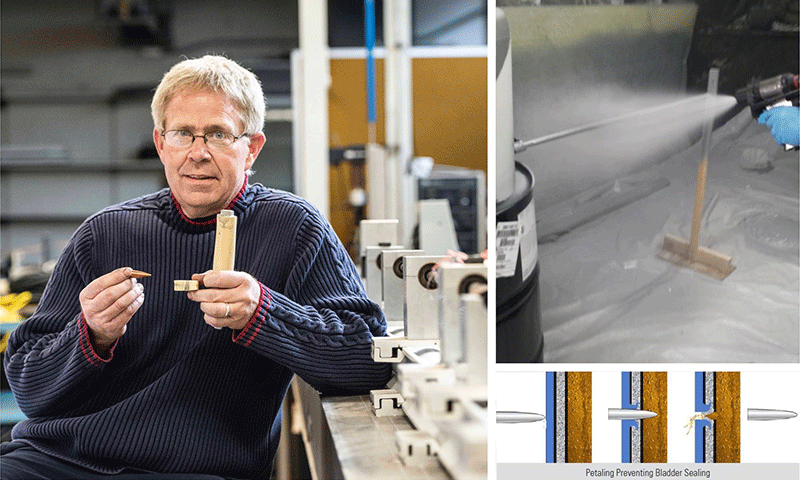Patents from the Naval Postgraduate School (NPS) are a measure of novel inventions, but each also tells a story of a relevant idea with warfighting impact. NPS Department of Physics Associate Professor Ray Gamache and his former graduate student, NPS alumnus U.S. Marine Corps Maj. Chris Phifer, developed and recently patented a new polymer-based, self-sealing fuel line capable of withstanding a .50 caliber bullet without losing so much as a single drop.
“We’re not just a physics department, we’re the applied physics department,” Gamache said. “While we’re doing things that involve fundamental research, what we’re ultimately doing is pursuing applied solutions with our military students that are important to the warfighter.”
Gamache credits the operational experience and tenacity of Phifer to develop and test multiple prototypes for his thesis to arrive at the right design of a “heterogeneous elastomer system” for a pressurized fuel line to immediately snap back into position sealing simulated combat damage.
“It was a process to build, test, learn until we got it right,” Phifer recalled. “The challenge was that I had to worry about both entry and exit points, so we created multiple 8-inch lengths of hose made from the polymers we selected, sealed on one side and a pressure fixture on the other, and found certain properties performed better on sealing the entry wound and others performed better sealing the exit wound.
“It was during the second phase of this process that we decided to incorporate multilayered polymers with opposing material characteristics, and discovered through trial and error that too many layers reduced the performance but the design with two different composites was able to self-seal.”
Self-sealing technology has been around for some time – since World War I, to be precise. Legacy systems relied on specific interactions with fossil fuels to function and thus proved obsolete with the introduction of new types of fuel. The challenge, Gamache explained, was finding the correct materials to employ.
After testing out various materials to varying effects, Gamache and Phifer found that polyureas and polythioureas worked best. Capable of 300 percent elongation – “rubber on steroids,” according to Gamache – the materials immediately “snapped back” after being pierced by the bullet.
“It isn’t rocket science,” Gamache said. “You simply need a material that has elongation and strength to it so that it has a memory of what it used to be like. When the bullet pokes a hole through it, it just goes back and pushes everything to where it used to be.”
While the research by Gamache and Phifer was initially conceived for aviation applications, Gamache noted that the technology can also apply beyond fuel lines.
“It can be any kind of line,” he said. “It’s a technology that gives you self-sealing and – most importantly – instantaneous self-sealing. There’s a lot being published on self-healing, i.e., closing up over time, but you don’t want self-healing on a fuel line because you’re going to be out of gas before long. Self-sealing is what we are after and elastomeric materials do that.”
Phifer is now stationed at U.S. Army Tank-automotive and Armaments Command (TACOM) helping develop the joint Advanced Reconnaissance Vehicle (ARV) for the Marine Corps, and agreed that the technology is important, but so is the process.
“This was a team effort with Dr. Gamache, the machine shop, the physics lab techs and even a summer high school intern,” Phifer added. “I have used what I learned from both my physics studies and my applied research process in my role with the ARV program. My time at NPS allowed me to work and understand physics and engineering concepts and develop my problem-solving skills to address the daily issues that arise in a program office.”
The research into self-sealing fuel lines may not fundamentally alter the face of modern warfare, but the technology developed has the potential to provide a marked battlespace advantage for America’s military forces. Increased survivability of warfighter and equipment, extended loiter times and decreased maintenance demands are just a few examples of this technology’s potential impact.
Entitled “Self-Sealing Hose,” the patent went public in November 2022 and is available for licensing through NPS’ Technology Transfer Program.
Innovation driven, NPS develops warfighters and warfighting solutions. Read more about the technology patent:
https://techlinkcenter.org/technologies/self-sealing-hose/7b946c58-00de-4437-8505-e98747d7295e
The primary objective of the NPS Technology Transfer Program is to initiate partnerships with industry and/or academia, license existing technologies, and encourage and assist faculty and staff to transfer newly-developed technologies to the private sector. For more information on the program and how to work with NPS, visit https://nps.edu/web/research/technology-transfer.


